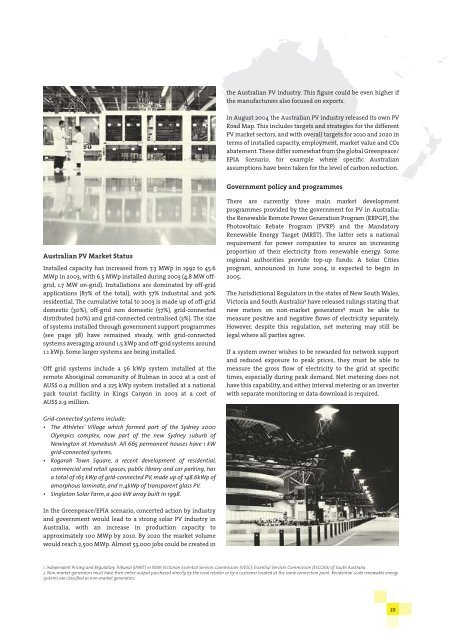SOLAR GENERATION - Greenpeace
SOLAR GENERATION - Greenpeace
SOLAR GENERATION - Greenpeace
Create successful ePaper yourself
Turn your PDF publications into a flip-book with our unique Google optimized e-Paper software.
the Australian PV industry. This figure could be even higher if<br />
the manufacturers also focused on exports.<br />
In August 2004 the Australian PV industry released its own PV<br />
Road Map. This includes targets and strategies for the different<br />
PV market sectors, and with overall targets for 2010 and 2020 in<br />
terms of installed capacity, employment, market value and COc<br />
abatement. These differ somewhat from the global <strong>Greenpeace</strong>/<br />
EPIA Scenario, for example where specific Australian<br />
assumptions have been taken for the level of carbon reduction.<br />
Government policy and programmes<br />
Australian PV Market Status<br />
Installed capacity has increased from 7.3 MWp in 1992 to 45.6<br />
MWp in 2003, with 6.5 MWp installed during 2003 (4.8 MW offgrid,<br />
1.7 MW on-grid). Installations are dominated by off-grid<br />
applications (87% of the total), with 57% industrial and 30%<br />
residential. The cumulative total to 2003 is made up of off-grid<br />
domestic (30%), off-grid non domestic (57%), grid-connected<br />
distributed (10%) and grid-connected centralised (3%). The size<br />
of systems installed through government support programmes<br />
(see page 38) have remained steady, with grid-connected<br />
systems averaging around 1.5 kWp and off-grid systems around<br />
1.1 kWp. Some larger systems are being installed.<br />
Off grid systems include a 56 kWp system installed at the<br />
remote Aboriginal community of Bulman in 2002 at a cost of<br />
AUS$ 0.9 million and a 225 kWp system installed at a national<br />
park tourist facility in Kings Canyon in 2003 at a cost of<br />
AUS$ 2.9 million.<br />
There are currently three main market development<br />
programmes provided by the government for PV in Australia:<br />
the Renewable Remote Power Generation Program (RRPGP), the<br />
Photovoltaic Rebate Program (PVRP) and the Mandatory<br />
Renewable Energy Target (MRET). The latter sets a national<br />
requirement for power companies to source an increasing<br />
proportion of their electricity from renewable energy. Some<br />
regional authorities provide top-up funds. A Solar Cities<br />
program, announced in June 2004, is expected to begin in<br />
2005.<br />
The Jurisdictional Regulators in the states of New South Wales,<br />
Victoria and South AustraliaB have released rulings stating that<br />
new meters on non-market generatorsC must be able to<br />
measure positive and negative flows of electricity separately.<br />
However, despite this regulation, net metering may still be<br />
legal where all parties agree.<br />
If a system owner wishes to be rewarded for network support<br />
and reduced exposure to peak prices, they must be able to<br />
measure the gross flow of electricity to the grid at specific<br />
times, especially during peak demand. Net metering does not<br />
have this capability, and either interval metering or an inverter<br />
with separate monitoring or data download is required.<br />
Grid-connected systems include:<br />
• The Athletes’ Village which formed part of the Sydney 2000<br />
Olympics complex, now part of the new Sydney suburb of<br />
Newington at Homebush. All 665 permanent houses have 1 kW<br />
grid-connected systems.<br />
• Kogarah Town Square, a recent development of residential,<br />
commercial and retail spaces, public library and car parking, has<br />
a total of 165 kWp of grid-connected PV, made up of 148.6kWp of<br />
amorphous laminate, and 11.4kWp of transparent glass PV.<br />
• Singleton Solar Farm, a 400 kW array built in 1998.<br />
In the <strong>Greenpeace</strong>/EPIA scenario, concerted action by industry<br />
and government would lead to a strong solar PV industry in<br />
Australia, with an increase in production capacity to<br />
approximately 100 MWp by 2010. By 2020 the market volume<br />
would reach 2,500 MWp. Almost 53,000 jobs could be created in<br />
1. Independent Pricing and Regulatory Tribunal (IPART) in NSW; Victorian Essential Services Commission (VESC); Essential Services Commission (ESCOSA) of South Australia.<br />
2. Non-market generators must have their entire output purchased directly by the local retailer or by a customer located at the same connection point. Residential-scale renewable energy<br />
systems are classified as non-market generators.<br />
39

















